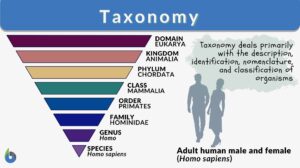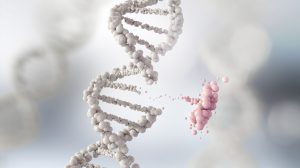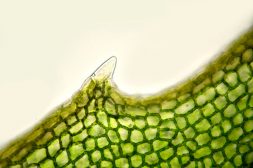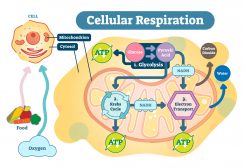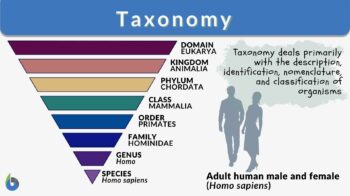
Taxonomy
n., tækˈsɑːnəmi
Definition: the science of finding, describing, classifying, and naming organisms
Table of Contents
Taxonomy Definition
The term “taxonomy” was developed from two Greek words, “taxis,” meaning arrangement, and “nomia,” meaning distribution or method. In simple words, the definition of taxonomy is a branch of science that deals primarily with the description, identification, nomenclature, and classification of organisms. It is essential to classify living organisms into different groups and subgroups.
What is Taxonomy? Taxonomy is the branch of biology that studies the naming, arranging, classifying, and describing organisms into groups and levels.
Defining Taxonomy
What do you mean by taxonomy? The scientific definition of taxonomy is that it involves the classification of organisms both alive and extinct. Also, it includes the naming and arranging of organisms in higher groups. So what does taxonomy mean? Taxonomy involves studying living organisms such as animals, plants, microorganisms, and humans to classify them in different categories to study further and identify. For instance, humans and whales are two unrelated organisms from different perspectives; however, both are considered mammals and taxonomically related.
Different definitions of taxonomy
The definitions of taxonomy in biology vary from one source two to another. Different authors have different points of view regarding taxonomy in biology. Here are the compiled definitions of taxonomy.
- Taxonomy involves seven different types of processes: description, naming, recognition, comparison, and classification of taxa, genetic variation, identifying specimens, and defining taxa in the ecosystem. (Enghoff & Seberg, 2006).
- Taxonomy is the practice of making groups of organisms (individuals) into species and arranging those species into larger groups and assigning names to the groups, to produce a classification. (Judd et al., 2007)
- The taxonomy is the field of science, including units of systematics to enclose the identification, description, classification, and nomenclature (Simpson, 2010).
- Taxonomy is an analysis of an individual’s characteristics to classify them. (Lawrence, 2005).
- Taxonomy is the study of the classification of living beings and their formation of species and vice versa (Walker, 1988).
- Taxonomy in biology is the arrangement of (living) organisms into classification. (Kirk, et al. 2008).
Based on different definitions, the taxonomy is considered a sub-branch of systematics or a synonym of the latter term. It is also thought that biological nomenclature is either a part of taxonomy or a unit of systematics. To remove this confusion, consider the given below definition of systematics:
Systematics is the consideration to identify the taxonomy of organisms and their nomenclature, classification based on their natural relatedness, and the analysis of variation and evolution among the taxa.
Overview of taxonomy biology
In biology, taxonomy is defined as the classification of biological organisms. Starting from grouping the organisms into taxa (singular: taxon) and then given taxonomic rank. These groups can be collected to form high-ranked supergroups that lead to the taxonomy hierarchy.
Who are taxonomists?
Taxonomists are biologists who analyze the relationship among organisms and aggregate them into groups. For instance, the insect taxonomist understands the relationship between different fly types and vice versa to group them into one category.
History of Taxonomy
The scientific taxonomy (classification of organisms) primarily occurred in the 18th century. However, the only basis that meets in the past to the early works only includes the descriptives of plants for agriculture and medicine purposes. Moreover, the early taxonomy was based on artificial systems or arbitrary criteria, including Linnaeus’s system. The later systems were called the natural systems, which include a more scientific taxonomy basis. The nature of these natural systems was based on pre-evolutionary thinking. Charles Darwin’s work on “Origin of Species” gave a more solid basis for the classification of organisms. The classification was based on the evolutionary relationships leading to phyletic systems since 1883.
Before the Linnaean era
The pre-Linnaean era includes the work of earlier taxonomists back in the Egyptian period from 1500 BC.
Early Egyptian taxonomists
The process of classifying and naming the surrounding organisms in human history is as long as language development occurs in humankind. An example of earlier taxonomy has been shown on Egypt’s walls about medicinal plants by early Egyptian taxonomists.
Aristotle
During Aristotle’s stay on the Island of Lesbos, he was able to classify organisms for the first time. He identified the organisms and then grouped them into two major categories, i.e., plants and animals. He classified the animals based on attributes and parts including, the number of legs, laying eggs, warm-blooded or no blood, and birth. Several groups of animals proposed by Aristotle, such as Anhaima, Enhaima, sharks, and cetaceans, are still used to this day. Anhaima includes animals with no blood. Currently, they are referred to as invertebrates, and Enhaima includes animals with blood. They are also called vertebrates.
His student, Theophrastus, continued the classification process and mentioned 500 plants (also their uses) in his book, Historia Plantarum. Some plant groups, such as Cornus, Crocus, and Narcissus, can be traced back to Theophrastus’s findings.
Medieval thinkers
In the middle ages, medieval thinkers took account of organisms’ classification on a philosophical basis. During Aristotle’s time, the unavailability of a microscope leads to no classification of plants and fungi. Afterward, the classification systems used in this era were Aristotelian systems, including the Scala Naturae, a nature ladder used to order organisms in one unit. The concepts that originated in the middle ages were a Great chain of being. The medieval thinkers include most prominent scholars like Thomas Aquinas, Demetrios, Procopius, and others. These scholars studied the above consideration to extract philosophical abstracts in organisms’ classification rather than logical or traditional taxonomy.
Andrea Cesalpino
Andrea Cesalpino, the first-ever taxonomist in history, was an Italian physician. He described up to 1500 species of plants in his book “Magnum Opus De Plantis“. The largest families of plants known as Asteraceae and Brassicaceae are still considered and used today.
John Ray
In the 17th century, John Ray took taxonomy to the next level and covered more important taxonomic aspects. His biggest accomplishment was his describing details of 18,000 plant species and more in his book “Methodus Plantarum Nova” and produced more complex classification (the taxa were based on many characteristics).
Joseph Pitton de Tournefort
Joseph Pitton de Tournefort defined and classified 9000 species in 698 genera in his work Institutiones Rei Herbariae, 1700.
Carl Linnaeus
Carl Linnaeus (also known as Carl von Linné or Carolus Linnæus) proposed his taxonomy classification system known as the Linnaean System. His works, such as Systema Naturae, Species Plantarum, and Systema Naturae, were the most famous and revolutionized in the taxonomy field. His works include introducing a binomial naming system that leads to organized and standardized animal and plant species taxonomy.
The system contains proper classification factors, including class, order, genus, and species. His books allow identifying animals and plants (for instance, the flower can be identified from its smaller parts). Moreover, in the present century, his work was being used in the 18th century. However, modern taxonomists consider the Linnaean System as the starter of taxonomy (biology). Furthermore, the period before Linnaean work (taxonomic names) is considered pre-Linnaean, and some of his proposed taxonomic names are also considered in the later era.
Different Taxonomists work on classification:
| Andrea Caesalpino (1519-1603 AD) | Divides plants into 15 groups |
| John Ray (1627-1705 AD) | Published work on plants classification |
| Augustus Rivinus (1652-1723 AD) | Added taxa of Order |
| Tournefort (1656-1708 AD) | Introduced taxa of Class |
| Linnaeus (1707-1778 AD) | Grouped species based on physical characteristics |
Classification Systems
The biologist needed a system to provide all this information to get full information about similarities and differences among different organisms. In earlier classification systems, the organism was divided and classified into two kingdoms that are plants and animals. In previous years the taxonomist agreed on a five-kingdom classification after developing the two-kingdom classification system and three-kingdom classification systems. However, in recent years the taxonomist agreed on five-kingdom classification systems. The only difference in the five-kingdom classification system and the six kingdom classification system is that the kingdom Protista was further divided into two kingdoms.
Two-kingdom classification system
In the beginning, the organisms were classified only into kingdoms: Animalia and Plantae. Following this system, Kingdom Plantae includes organisms capable of preparing their food from simple inorganic materials. They are also named autotrophs. On the contrary, those organisms that cannot prepare their food from simple inorganic material and depend on other autotrophs to get food were named heterotrophs and placed in Kingdom Animalia.
In this classification system, the taxonomists placed bacteria, fungi, and algae in Kingdom Plantae. Based on more advanced research, the taxonomists contested this classification system and thought it was not workable. Euglena, for instance, has both plant-like (e.g. the presence of chlorophyll for photosynthesis) and animal-like features (e.g. heterotrophic mode of nutrition in the night and no cell wall). So where should this organism be classified? As a result, another classification system was needed to classify such organisms.
Three-kingdom classification system
A taxonomist named Ernst Hackel solve the previous problem in 1866. He made a third kingdom Protista to place organisms like Euglena. He also included bacteria in the third kingdom. However, the fungi have remained in the Plantae kingdom. Many biologists did not accept the position of fungi in the Kingdom Plantae. Thus, the three-kingdom classification system was still insufficient to clearly classify organisms. Besides, the differences between prokaryotes and eukaryotes are not considered in this classification scheme.
Fungi resemble plants in many ways but cannot prepare their food (not considered autotrophs). Instead, they get food by absorption. They do not contain cellulose and have chitin in cell walls, making them characteristically heterotrophs.
Five-kingdom classification system
The term “procariotique” was used to describe bacteria, and “eucaritique” was used to describe plants and animal cells by E. Chatton in 1937. Robert Whittaker introduced the five-kingdom classification system in 1967. The system was based on the following;
- The system gave levels to the cellular organization, including prokaryotic, unicellular eukaryotic, and multicellular eukaryotic.
- Based on modes of nutrition, that is photosynthesis, absorption, and ingestion.
On these bases, the organisms were classified into five kingdoms, such as Monera, Protista, Fungi, Plantae, and Animalia. Further, changes were made in the five-kingdom classification system by Margulis and Schwartz in 1988. Nevertheless, the most latest and recent changes made in this classification system include the Protista kingdom’s division. The detail of each kingdom is given in later sections.
Taxonomy Hierarchy
The process of placing or grouping organisms in different taxonomic groups is known as the taxonomy hierarchy. These levels formed a structure similar to the ladder or pyramid. The organisms are grouped in ascending to descending classification order and vice versa. The highest level is considered to be the domain and the least one as species.
Taxonomic ranks
The levels, as mentioned earlier in biological classification, are also called taxonomic ranks. Each rank leads to other taxonomic ranks either in an upward direction or downward. In the next section, we will go through the taxonomic ranks in biological or scientific classification, building the taxonomy hierarchy.
Taxonomy hierarchy overview
Below is the quick taxonomic definition of each rank:
- Domain – highest level constitutes three domains of life.
- Kingdom – the second most level constitutes five kingdoms.
- Phylum – a group of related classes.
- Class – a group of related orders.
- Order – a group of related families.
- Family – a group of related genera.
- Genus – a group of related species.
- Species – a group of similar organisms.
Domain
Domain as a taxonomic level or rank was added in the taxonomic hierarchy in 1990 after 250 years of Linnaean taxonomy classification development. The early taxonomists did not taxonomically add the Domain yet. Moreover, the taxonomic level includes three life domains, such as Eukaryota, Archaea, and Bacteria.
Eukaryota refers to all the organisms living on earth (but neither a bacterium nor an archaeon). Nevertheless, they are more related to Archaea Domain.
Archaea include single-celled organisms that are evolutionarily close to bacteria and make habitats in mild or extreme places.
Bacteria include all the bacteria (single-celled microorganisms) found in a large number than all animals and plants on the earth.
Note: The capital ‘B’ for Bacteria is used to define the Domain, and the bacteria with small ‘b’ is used for all the bacteria on the earth.
Kingdom
Initially, there were two kingdoms: Animalia and Plantae. However, after the development of the microscope and more research, more kingdoms were added. In the past year, the number of kingdoms was five: Monera, Animalia, Plantae, Protista, and Archaea. These Kingdoms were recently raised to seven. Due to the inaccuracy of some Kingdoms such as Protista, which include eukaryotic organisms that do not belong to other classes ( i.e., they are not plants or animals), it led to new kingdoms — by splitting Protista into Chromista and Protozoa. The current Kingdoms in taxonomy classification are as follows:
(1) Kingdom Animalia
Almost all the animals are included in the kingdom of Animalia. These animals ingest food and digest it with the help of particular organs. They are eukaryotic, multicellular organisms and have no cell walls. These animals move from one place to another. The kingdom Animalia also includes humans (used in informal terms); however, animals are only used for animals different from humans.
Most animal species are bilateral, meaning they have a bilaterally symmetric body, including nematodes, mollusks, arthropods, echinoderms, chordates, and others.
For an animal classification chart example, see Example 2 in the section: Examples of Taxonomy.
(2) Kingdom Plantae
This kingdom includes eukaryotic, multicellular autotrophs meaning all plants. The kingdom Plantae is also referred to as the Metaphyta kingdom. This kingdom includes multicellular and eukaryotic photosynthesis plants. These plants are capable of making their food by the process called photosynthesis. They reproduce and have sex organs, which are multicellular forming embryos. Plants exist long ago on the earth and are more than 250,000 species. The plant’s green color and ability to produce oxygen shape the environment by removing carbon dioxide. Mosses, ferns, and flowering plants are included in the kingdom Plantae.
(3) Kingdom Monera
The organisms which are made of prokaryotic cells are included in the kingdom Monera. They are unicellular, although some types form clusters, colonies, and changes of cells. Prokaryotic cells are different from eukaryotic cells radically. Some organisms in the kingdom Monera produce their food through photosynthesis, and most of them are heterotrophs, meaning they cannot produce their food and rely on other plants and animals such as algae. The organisms that perform photosynthesis have chlorophyll in their cytoplasm. The kingdom Monera includes two different kinds of organisms that are cyanobacteria and bacteria.
(4) Kingdom Fungi
The organisms included in the kingdom fungi have the absorptive nutritional mode. They are eukaryotic, multicellular heterotrophs, for example, mushrooms. Most of the fungi are decomposers. They secrete digestive enzymes of organic material on which they live. They also absorb small organic molecules that are formed as the result of digestion by enzymes. Other microorganisms included in fungi are molds and yeasts. The reason for fungi’s separate kingdoms is the presence of chitin in their cell walls. Fungi are also heterotrophs like animals. They get their food by the absorption (of organic molecules) process and lack photosynthesis. The fungi are decomposers that grow through the mean of mobility. The kingdom contains a wide variety of taxa and ecologies, morphologies, and life cycle stages. The estimated biodiversity of kingdom fungi ranges from 2.2 million to 3.8 million.
(5) Kingdom Chromista
Kingdom Chromista is derived from the kingdom Protista, created by Thomas Cavalier in 1981 to separate all protists from plant protozoans. The kingdom Chromista includes eukaryotic organisms, both single-celled and multicellular. Initially, the algae were also included in the chromista kingdom, which was then excluded based on protozoans belonging to a new group. The organisms in the kingdom Chromista have similar characteristics in terms of photosynthetic processing. Several examples of these eukaryotic organisms include diatoms, oomycetes, and some algae containing chlorophyll in their plastids.
(6) Kingdom Protozoa
The kingdom protozoa include single-celled eukaryotic organisms free-living for parasites, meaning they feed on microorganisms, debris, and organic tissues (organic matter). They are also considered one-celled animals because of the features similar to animals like locomotion, no cell wall, and predatory features. However, this consideration is now ended, and the protozoans are neither identified as animals, plants, nor fungi categories. Moreover, the protozoans are given a separate kingdom because they are single-celled eukaryotic organisms with heterotrophic feeding characteristics.
(7) Kingdom Archaea
The unicellular prokaryotes microorganisms considered to be the oldest organisms found on earth are included in kingdom archaea. These microbes do not contain a cell nucleus and other organelles with membrane-bound structures. Initially, the archaea were considered bacteria; however, it was separated from bacteria due to the advancement and further research (kingdom: Archaebacteria ). Archaea have different sizes and shapes. They also contain genes and metabolic pathways that make them similar to eukaryotes. The kingdom archaea contain multiple phyla. The classification of organisms included in the kingdom archaea is crucial because they are not isolated in laboratories for examining purposes. Moreover, the archaea take up the energy in the form of sugars, ammonia, hydrogen gas, and metal ions from the organic materials. Some archaea use sunlight for energy purposes and to fix carbon.
Phylum
The taxonomic definition of phylum (plural: phyla) is more precise than the kingdom and less particular than the class level. The phylum was added to the taxonomic classification in the 19th century. There are 34 Phyla of animals, 13 Phyla of plants, 8 Phyla of fungi, 20 Phyla of Protista (including Chromista and Protozoa), 29 Phyla of bacteria, and five phyla of Archaea. The List of Prokaryotic Names with Standing in Nomenclature (LPSN) accepts these lists of phyla. Some of the notable phyla of animals include Chordata (includes organisms with nerve cords), Arthropoda (arthropods), and Porifera (sponges).
Class
A more specific taxonomic rank than a phylum is the class. The class was integrated into the taxonomy (biology) by the Linnaean system and was the most widespread taxa used up till now. However, the classes for plants proposed by Linnaean are not used nowadays because plants’ classes were made based on their attributes (e.g. petals arrangement) rather than by their similarities. The classes for plants are not used much in botany (the study of plants).
In animals, there are 108 classes and the most common among these are Mammalia (mammals), Aves (birds), and Reptilia (reptiles).
Order
Next to class is the order. It is a more specific taxonomic rank. Some Linnaean orders are still used in the present taxonomies. The rough estimate of the total number of orders ranges from 420-450.
The Mammalian, for instance, has orders between 19- 26, including Primates, Carnivora (animals that are carnivores or omnivores), Cetaceans (water animals like whales, porpoises, and dolphins), and Chiroptera (including bats).
Family
The taxonomic family is more specific than the order. Several examples of Order Carnivora families are Canidae (dogs, foxes, or wolves), Mephitidae (skunks), and Felidae (cats).
Genus
A more specified taxonomic rank in the taxonomy hierarchy is the genus (plural: genera). The genus includes the scientific names of organisms (species name and genus name). The scientific names are written in the Italic style, and the genus name is always capitalized. For instance, the scientific name of the human is Homo sapiens. Homo is the genus name, and sapiens is the species name.
Species
The approximate number of species on the earth is 8.7 million. However, there are still many species left for taxonomic classification and ranking. The species is the most specified rank in the taxonomy hierarchy. The same species name can be used for different organisms such as an American black bear is called Ursus americanus and the American toad as Bufo americanus. The species name is never capitalized and always written in an Italic script; moreover, in scientific articles or research papers, the species name is followed by the genus’s first letter; for example, the Homo sapiens is written H. sapiens.
Read: The Homo Species – Biology Online Tutorial
Evolution in taxonomy
Evolution is a progressive change that proceeds through genetic variation, natural selection, and genetic drift. Through evolution, living things evolve to thrive and adapt to the ever-changing environment. Because of this, there is a tendency for a certain group of organisms to evolve so markedly that they diverge into different groups within the group. New species emerge.
The process of the formation of new species is called speciation. There are various ways to achieve this:
In spite of this basic tenet, there are certain people who still question evolution. For instance, the question is as to why not all apes evolved into humans if humans truly originated from the apes. Questions like this make some people argue that evolution is wrong and simply a theory. However, modern proponents of evolution claim that humans do not precisely originate from apes but from an ape-like common ancestor that we share with the apes, even with monkeys. And also, humans did not stop evolving. Modern humans are undergoing evolution and some of the factors of it include mutations (genetic variation), environmental factors, and natural selection. For example, some humans have adapted to live life in high altitudes. Tibetans, for example, are capable of thriving in a low oxygen environment, which people who are used to living in the lowlands will experience difficulty in breathing going up to the highlands. Scientists found out that Tibetans have alleles that cause them to produce relatively fewer red blood cells, which is an essential feature for living in high altitudes. The fewer number of red blood cells in their blood is an advantage because it prevents the blood from becoming thicker (by thicker, it means having more blood cells making the passage through capillaries rather difficult). The trait wherein there are few red blood cells circulating seems to help in effectively delivering oxygen to tissues. Apart from it, other traits that are unique to Tibetans are having blood vessels that expand to allow better oxygen transport and a higher breathing rate.
Taxonomy chart: sample classification of two organisms
| Taxonomic ranks | Dog | Peas |
| Domain | Eukaryote | Eukaryote |
| Kingdom | Animalia | Plantae |
| Phylum | Chordata | Magnoliophyta |
| Class | Mammalia | Magnoliopsida |
| Order | Carnivora | Fabales |
| Family | Canidae | Fabaceae |
| Genus | Canis | Pisum |
| Species | C. lupus | P. sativum |
Examples of Taxonomy
To understand how the taxonomy hierarchy works and how different organisms are grouped under one kingdom.
Example 1: Taxonomy of Human
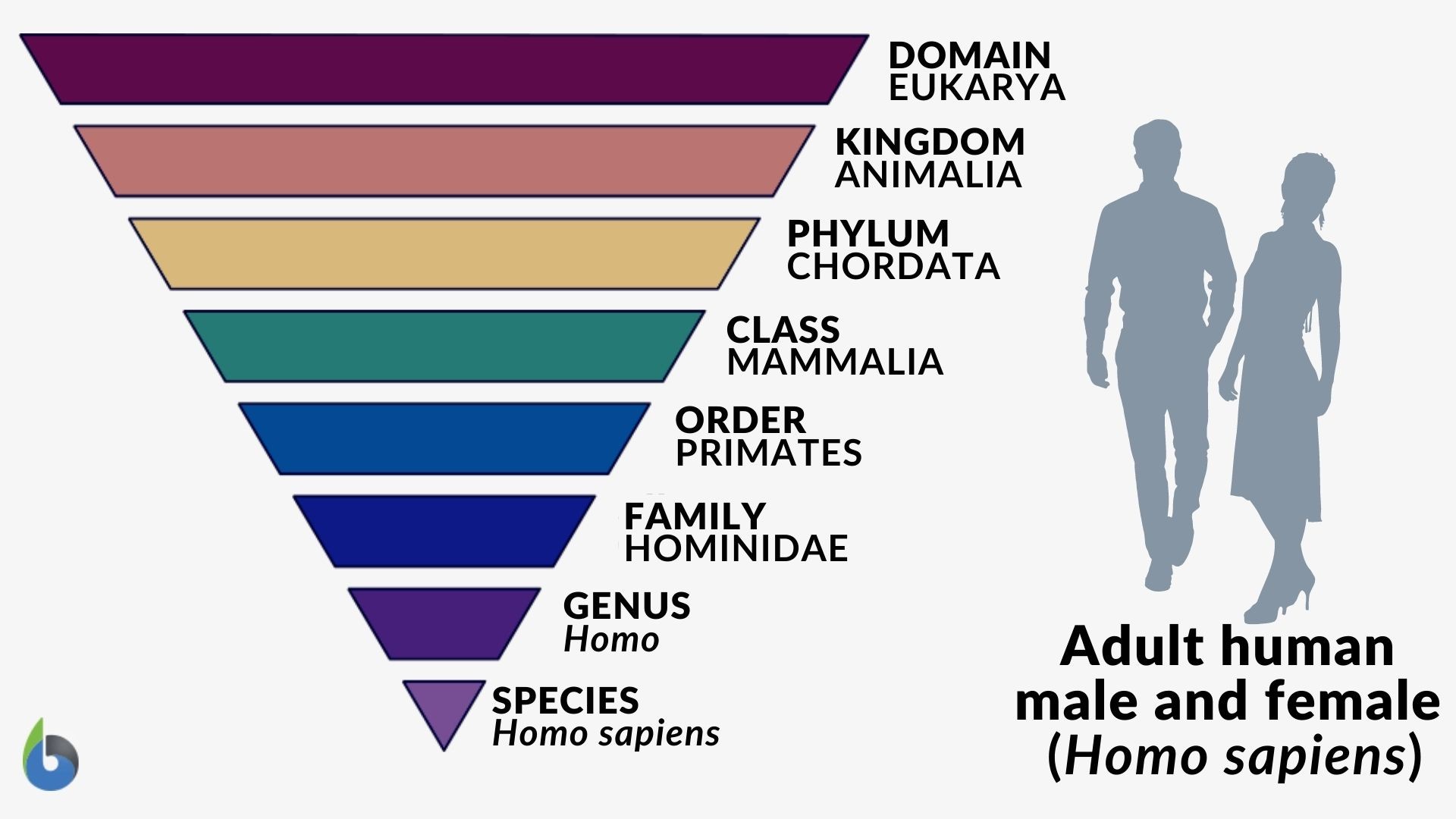
Example 2: Taxonomy Hierarchy of Dog

Try to answer the quiz below to check what you have learned so far about taxonomy.
©BiologyOnline.com. Content provided by BiologyOnline Editors.
References
- Enghoff, H. (2009) What is taxonomy? An overview with myriapodological examples. Natural History Museum of Denmark, University of Copenhagen, Universitetsparken, 1864 – 6417
- Judd, W.S., Campbell, C.S., Kellogg, E.A., Stevens, P.F., & Donoghue, M.J. (2007). “Taxonomy“. Plant Systematics: A Phylogenetic Approach (3rd ed.). Sunderland: Sinauer Associates.
- Kirk, P.M., Cannon, P.F., Minter, D.W., & Stalpers, J.A. eds. (2008) “Taxonomy“. In Dictionary of the Fungi, 10th edition. CABI, Netherlands.
- Lawrence, E. (2005). Henderson’s Dictionary Of Biology. Pearson/Prentice Hall. ISBN 978-0-13-127384-9.
- Manktelow, M. (2010) History of Taxonomy Archived 29 May 2015 at the Wayback Machine. Lecture from Dept. of Systematic Biology, Uppsala University.
- Simpson, Michael G. (2010). “Chapter 1 Plant Systematics: an Overview“. Plant Systematics (2nd ed.). Academic Press. ISBN 978-0-12-374380-0.
- Walker, P.M.B., ed. (1988). The Wordsworth Dictionary of Science and Technology. W.R. Chambers Ltd. and Cambridge University Press.
- Wilkins, J.S. (5 February 2011). “What is systematics and what is taxonomy?“. Archived from the original on 27 August 2016. Retrieved 21 August 2016.

